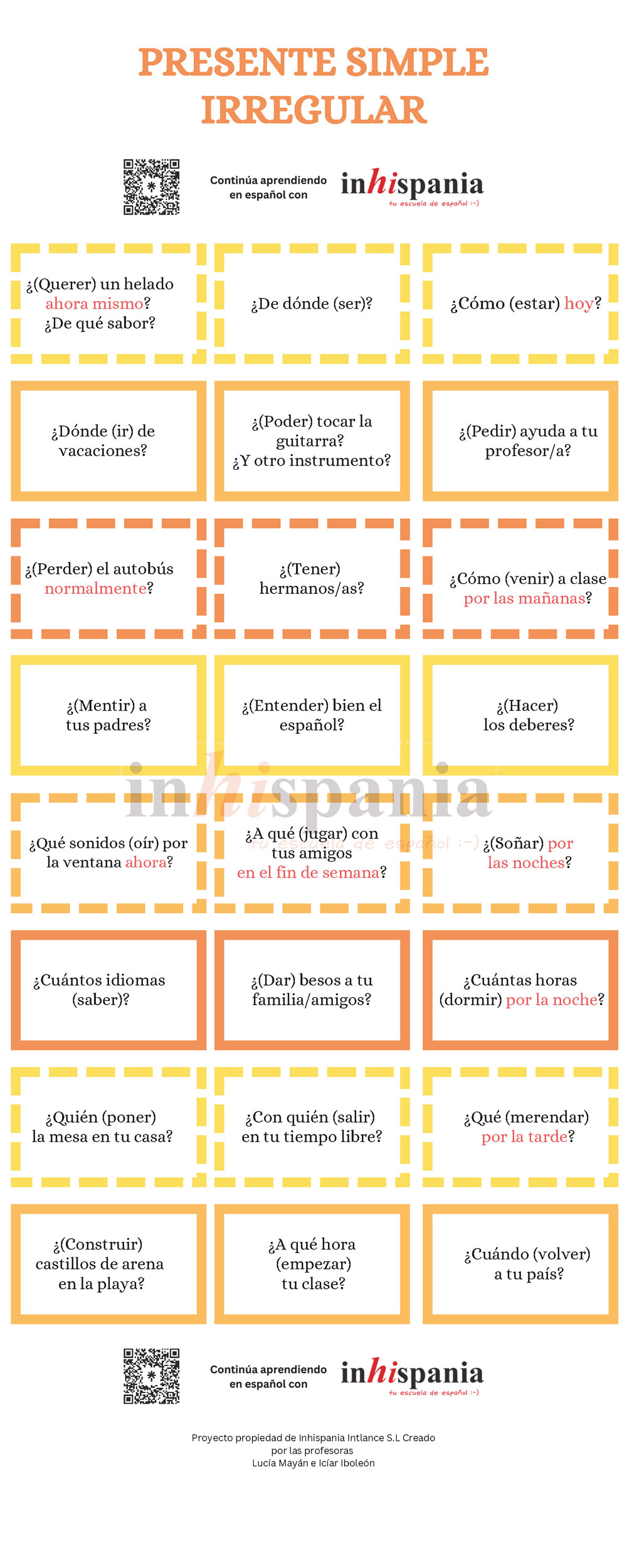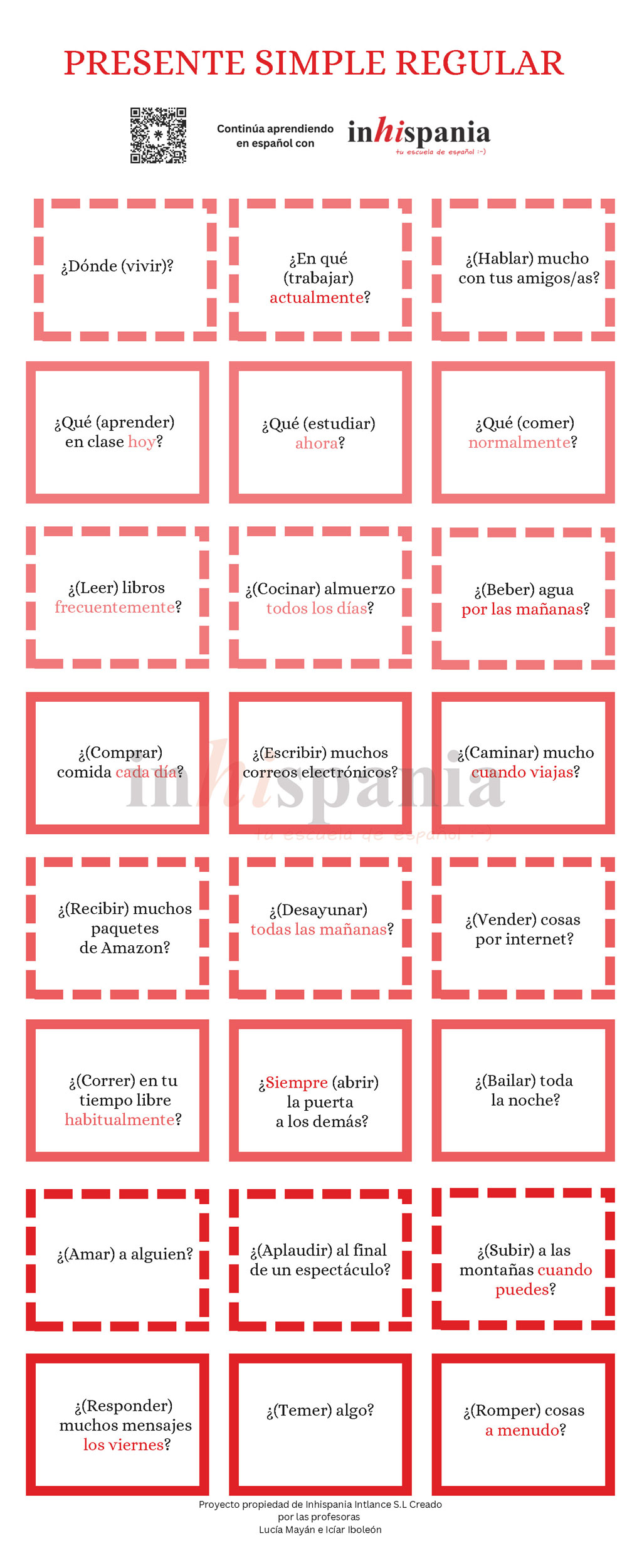Learning a new language is always an exciting and enriching challenge. For foreign students who are learning Spanish, knowing how to use verbs in the present tense is a crucial aspect of everyday communication. While it may seem complicated at first due to the various verb conjugations, irregular forms, and uses, with dedication and some helpful tips, you can improve your command of present tense verbs in Spanish effectively.
1. Understand the Importance of the Present Tense in Spanish
The Present Indicative in Spanish is not only used to describe actions that are happening in the current moment (for which we also use “estar + gerundio”), but it is also employed to express habitual actions, general facts, and future events. Understanding this versatility is essential for effective communication.
Actions in the current moment
- El profesor explica (está explicando) la lección en este momento.
The teacher is explaining the lesson right now.
- Ahora me como (me estoy comiendo) una manzana.
I am eating an apple now.
Habitual actions
- Siempre desayuno café por las mañanas.
I always have coffee in the mornings.
- Los lunes, mi hermana va al gimnasio.
On Mondays, my sister goes to the gym.
General facts
- El agua hierve a 100 grados Celsius.
Water boils at 100 degrees Celsius.
- Los seres humanos necesitan agua para vivir.
Humans need water to live.
Future events
- Mañana viajo (= viajaré) a Sevilla para una conferencia.
Tomorrow, I am traveling to Seville for a conference.
- Esta tarde quedo ( = quedaré) con mis amigos.
This afternoon, I’m meeting my friends..
2. Learn Basic Regular Verb Conjugations
In Spanish, verbs are conjugated according to the person (yo, tú, él/ella, nosotros, vosotros, ellos/ellas), tense (present, past, future, etc.) and modus (indicative, subjunctive, imperative). Start by learning the basic present indicative tense conjugations for regular verbs ending in –ar, –er, and -ir.
For example:
- Hablar (to speak):
- Yo hablo = I speak
- Tú hablas
- Él/Ella habla
- Nosotros/Nosotras hablamos
- Vosotros/Vosotras habláis
- Ellos/Ellas hablan
- Comer (to eat):
- Yo como = I eat
- Tú comes
- Él/Ella come
- Nosotros/Nosotras comemos
- Vosotros/Vosotras coméis
- Ellos/Ellas comen
- Vivir (to live):
- Yo vivo = I live
- Tú vives
- Él/Ella vive
- Nosotros/Nosotras vivimos
- Vosotros/Vosotras vivís
- Ellos/Ellas viven
3. Learn Irregular Verb Conjugations
Once you’ve mastered regular conjugations, move on to irregular ones. Irregularities are important to know when studying Spanish, as they affect verb forms in the present tense and can appear in a variety of contexts.
- “-cer” and “-cir” Verbs: Verbs like “conducir” (conduzco), “traducir” (traduzco), and “ofrecer” (ofrezco) have an irregularity in the first person singular (yo).
- “-ir” Verbs: Verbs ending in “-ir” with a stressed vowel in the root change the stressed vowel in some forms, like changing “e” to “ie” in “pensar” (pienso) and “o” to “ue” in “dormir” (duermo).
- “-uir” Verbs: Verbs like “huir” (huyo) also change the stressed vowel in some forms, following the pattern of “e” to “ie.”
- Verbs with “-go”: Some verbs, like “tener” (tengo), “venir” (vengo), and “decir” (digo), have irregular forms in the first person singular (yo).
- Verbs with “-zco”: Verbs like “conocer” (conozco) and “traducir” (traduzco) have an irregularity in the first person singular (yo).
- Verbs changing vowel to diphthong e> ie / o > ue: Verbs with a stressed vowel in the root change the stressed vowel in a diphthong, like “pensar” (pienso, piensas, piensas, pensamos, pensáis, piensan) or “dormir” (duermo, duermes, duerme, dormimos, dormís, duermen).
- Verbs changing vowel e >i: verbs like “pedir” (pido, pides, pide, pedimos, pedís, piden) o “seguir” (sigo, sigues, sigue, seguimos, seguís, siguen).
- Verbs with Changes in All Persons: Some verbs, like “ser” (soy, eres, es, somos, sois, son) and “ir” (voy, vas, va, vamos, vais, van), have completely irregular conjugations in all persons of the present indicative.

4. Practice with Conjugation Exercises
Once you’ve learned the basic verb conjugations in Spanish, spend time practicing with conjugation exercises. You can find exercise books, websites, and apps that offer a variety of exercises to strengthen your skills.
5. Use Flashcards and Memory Apps
Flashcards or memory apps are excellent tools for learning and memorizing verb conjugations in Spanish. Create cards with the verb on one side and its present tense conjugation on the other. Review them regularly to reinforce your knowledge. This technique is also effective for expanding your Spanish vocabulary.
We’ve provided links to cards for practicing regular (LINK PDF A1002) and irregular (LINK PDF A1003) present tenses.
6. Try to Listen and Speak in Spanish Daily
Oral practice is crucial for mastering the present tense in Spanish. Listen to music, podcasts, TV shows, movies, or series in Spanish to become familiar with the sounds and intonation of the language. Try to speak in Spanish every day, ideally with native speakers. The more you practice, the more confident you’ll become in using the present tense in real-life situations. You can search for online language exchange groups or local language exchange events to have regular conversations with Spanish native speakers.
7. Write in Spanish Regularly
Written expression is another effective tool for practicing the present tense in Spanish. Keep a diary in Spanish, write emails or text messages to Spanish-speaking friends, or even start a blog in Spanish. This practice will help you apply verb conjugations and improve your written fluency. Don’t be afraid to make mistakes, as they are a natural part of the learning process. We all learn through practice!

8. Take Spanish Classes
Consider enrolling in Spanish classes with a qualified teacher or at an accredited language center. Classes provide a solid structure and the opportunity to receive personalized feedback, which is invaluable for your progress. A teacher can help you understand the subtleties of verb conjugation in the present tense and address your specific questions.
9. Participate in Language Exchanges
Language exchanges are an excellent way to practice the present tense in Spanish while helping others learn your native language. You can find language exchange partners online or in your local community and spend time conversing in both languages. This experience will allow you to apply what you’ve learned and enhance your confidence in speaking in the present tense.
If you apply these tips and add patience and dedication, you will become a more fluent and confident Spanish speaker. If you also have the opportunity to spend time in a Spanish-speaking country, the results will be incredible. We suggest an intensive course in the heart of Madrid (school link) combined with sociocultural activities that include language exchange every week. Keep up the good work and master the present tense in Spanish!









